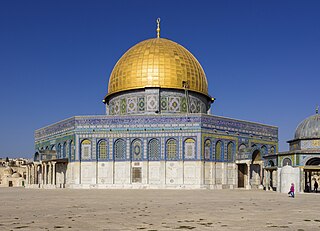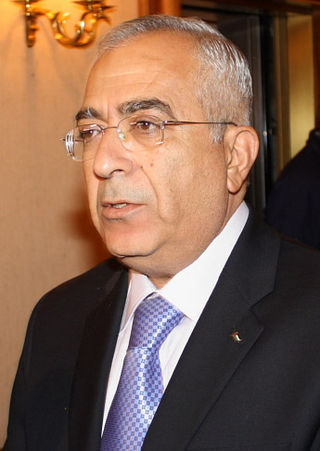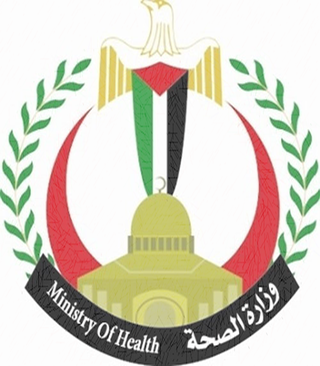Related Research Articles

The Gaza Strip, or simply Gaza, is a polity and the smaller of the two Palestinian territories. On the eastern coast of the Mediterranean Sea, Gaza is bordered by Egypt on the southwest and Israel on the east and north.

The Palestinian National Authority, commonly known as the Palestinian Authority and officially the State of Palestine, is the Fatah-controlled government body that exercises partial civil control over West Bank areas "A" and "B" as a consequence of the 1993–1995 Oslo Accords. The Palestinian Authority controlled the Gaza Strip prior to the Palestinian elections of 2006 and the subsequent Gaza conflict between the Fatah and Hamas parties, when it lost control to Hamas; the PA continues to claim the Gaza Strip, although Hamas exercises de facto control. Since January 2013, the Palestinian Authority has used the name "State of Palestine" on official documents, although the United Nations continues to recognize the Palestinian Liberation Organization (PLO) as the "representative of the Palestinian people".

The West Bank, so called due to its relation to the Jordan River, is the larger of the two Palestinian territories. A landlocked territory near the coast of the Mediterranean Sea in the Levant region of West Asia, it is bordered by Jordan and the Dead Sea to the east and by Israel to the south, west, and north. The territory has been under Israeli occupation since 1967.

The Israeli–Palestinian conflict, is an ongoing military and political conflict about self-determination within the territory of the former Mandatory Palestine. Key aspects of the conflict include the Israeli occupation of the West Bank and Gaza Strip, the status of Jerusalem, Israeli settlements, borders, security, water rights, Palestinian freedom of movement, and the Palestinian right of return.

The history of the State of Palestine describes the creation and evolution of the State of Palestine in the West Bank and Gaza Strip.

The Palestinian territories are the two regions of the former British Mandate for Palestine that have been occupied by Israel since the Six-Day War of 1967, namely the West Bank and the Gaza Strip. The International Court of Justice (ICJ) has referred to the West Bank, including East Jerusalem, as "the Occupied Palestinian Territory", and this term was used as the legal definition by the ICJ in its advisory opinion of July 2004. The term occupied Palestinian territory was used by the United Nations and other international organizations between October 1999 and December 2012 to refer to areas controlled by the Palestinian National Authority, but from 2012, when Palestine was admitted as one of its non-member observer states, the United Nations started using exclusively the name State of Palestine. The European Union (EU) also uses the term "occupied Palestinian territory". The government of Israel and its supporters use the label "disputed territories" instead.

Palestine, officially the State of Palestine, is a state in the Southern Levant region of West Asia. Founded on 15 November 1988 and officially governed by the Palestine Liberation Organization (PLO), it claims the West Bank and the Gaza Strip as its territory, all of which have been Israeli-occupied territories since the 1967 Six-Day War. The West Bank contains 165 Palestinian enclaves that are under partial Palestinian rule, but the remainder, including 200 Israeli settlements, is under full Israeli control. The Gaza Strip was governed by Egypt but conquered by Israel in 1967. Israel governed the region until it withdrew in 2005. The United Nations, the International Committee of the Red Cross, and various human-rights organizations still consider Gaza to be held under Israeli military occupation, due to what they regard as Israel's effective military control over the territory; Israel disputes this. Hamas seized power after winning the 2006 Palestinian legislative election. This has since been ensued by a blockade of the Gaza Strip by Israel and Egypt.

The economy of the State of Palestine refers to the economic activity of the State of Palestine. Palestine receives substantial financial aid from international donors, including governments and international organizations. This aid is crucial for supporting the Palestinian Authority and funding public services and development projects. Palestinians working abroad send money back to their families in Palestine. These remittances provide a significant source of income for many households.

Salam Fayyad is a Jordanian-Palestinian politician who served as the prime minister of the Palestinian Authority and the finance minister.
International aid has been provided to Palestinians since at least the 1948 Arab–Israeli War. The Palestinians view the aid as keeping the Israeli–Palestinian peace process going, while Israelis and other foreign policy authorities have raised concerns that it is used to fund terrorism and removes the imperative for Palestinians to negotiate a settlement of the Israeli–Palestinian conflict. As a provision of the Oslo Accords, international aid was to be provided to the Palestinians to ensure economic solvency for the Palestinian National Authority (PA). In 2004, it was reported that the PA, within the West Bank and Gaza Strip, receives one of the highest levels of aid in the world. In 2006, economic sanctions and other measures were taken by several countries against the PA, including suspension of international aid following Hamas' victory at the Palestinian Legislative Council election. Aid to the PA resumed in 2008 following the Annapolis Conference, where Hamas was not invited. Aid has been provided to the Palestinian Authority, Palestinian non-governmental organizations (PNGOs) as well as Palestinian political factions by various foreign governments, international organizations, international non-governmental organizations (INGOs), and charities, besides other sources.
The water resources of Palestine are de facto fully controlled by Israel, and the division of groundwater is subject to provisions in the Oslo II Accord.
Communications in the State of Palestine occur across many media, including telephone, radio, television, and internet. The telecom infrastructure is growing at a very rapid pace and continually being updated and expanded.

Ali Jarbawi is the former Minister of Planning and Administrative Development and the former Minister of Higher Education of the Government of the Palestinian National Authority.
The Portland Trust was established to promote peace and stability between Israelis and Palestinians through economic development. It works with a range of partners to help develop the Palestinian private sector and relieve poverty through entrepreneurship in Israel. It facilitates sustainable economic development through catalysing initiatives to build quality employment and thriving private sectors. Their work advances the growth of strong societies in Israel and Palestine based on socio-economic mobility and inclusion for minorities and marginalised groups.

The lives of Palestinian women have transformed throughout many historical changes including Ottoman control, the British Mandate, and Israeli occupation. The founding of the Palestine Liberation Organization in 1964 and the later establishment of the Palestinian Authority in 1994 also played a role in redefining the roles of women in Palestine and across the Palestinian diaspora. Women have been involved in resistance movements in Palestine, Jordan, Syria, and Lebanon throughout the 20th century and into the 21st century.

Healthcare in the State of Palestine refers to the governmental and private healthcare providers to which residents in the claimed territory have access. Since 1967, there have been improvements in the access to healthcare and the overall general health conditions for residents. Advances in training, increased access to state-of-the-art medical technology, and various governmental provisions have allowed per-capita funding to increase, and therefore the overall health of residents in the region to increase. Additionally, the enhanced access to and funding from international organizations like the World Health Organization, the United Nations, the Palestinian Ministry of Health, and the World Bank Education and Health Rehabilitation Project have contributed to the current state of affairs within the healthcare segment of the Palestinian territories.
Abu Dis is a Palestinian town in the Jerusalem Governorate of the Palestinian National Authority bordering Jerusalem. Since the 1995 Interim Agreement on the West Bank and the Gaza Strip, Abu Dis has been part of "Area B", under joint Israeli and Palestinian control. According to the Palestinian Central Bureau of Statistics (PCBS) census, Abu Dis had a population of 10,782 in 2007.

Israel–Palestine relations refers to the political, security, economical and other relations between the State of Israel and the State of Palestine. Israel and the PLO began to engage in the late 1980s and early 1990s in what became the Israeli–Palestinian peace process, culminated with the Oslo Accords in 1993. Shortly after, the Palestinian National Authority was established and during the next 6 years formed a network of economic and security connections with Israel, being referred to as a fully autonomous region with self-administration. In the year 2000, the relations severely deteriorated with the eruption of the Al-Aqsa Intifada – a rapid escalation of the Israeli–Palestinian conflict. The events calmed down in 2005, with reconciliation and cease fire. The situation became more complicated with the split of the Palestinian Authority in 2007, the violent split of Fatah and Hamas factions, and Hamas' takeover of the Gaza Strip. The Hamas takeover resulted in a complete rift between Israel and the Palestinian faction in the Gaza Strip, cancelling all relations except limited humanitarian supply.
Palestine produces no oil or natural gas and is predominantly dependent on the Israel Electric Corporation (IEC) for electricity. According to UNCTAD, the Palestinian Territory "lies above sizeable reservoirs of oil and natural gas wealth" but "occupation continues to prevent Palestinians from developing their energy fields so as to exploit and benefit from such assets." In 2012, electricity available in West Bank and Gaza was 5,370 GW-hour, while the annual per capita consumption of electricity was 950 kWh. National sources only produce 445 GWh of electricity, supplying less than 10% of demand. The only domestic source of energy is the disputed Gaza Marine gas field, which has not yet been developed. Palestinian energy demand increased rapidly, increasing by 6.4% annually between 1999 and 2005. Future consumption of electricity is expected to reach 8,400 GWh by 2020 on the expectation that consumption will increase by 6% annually.
There are a wide variety of views regarding the legal status of the State of Palestine, both among the states of the international community and among legal scholars. The existence of a state of Palestine, although controversial, is a reality in the opinions of the states that have established bilateral diplomatic relations. It is a non-member observer state at the United Nations since November 2012. As of 2 June 2023, a total of 139 countries recognize it.
References
- 1 2 3 4 "Environmental Quality Authority: Environment Sector Strategy Executive Summary" . Retrieved 29 April 2014.
- 1 2 3 4 "Ministry of Environmental Affairs: About MEnA". Archived from the original on 4 March 2016. Retrieved 29 April 2014.
- ↑ Desk Study on the Environment in the Occupied Palestinian Territories. United Nations Environment Programme. April 28, 2014. p. 112. ISBN 9789211586183.
- ↑ "UN News Centre: Lack of sufficient services in Gaza could get worse without urgent action, UN warns" . Retrieved 29 April 2014.
- ↑ "Goal 7: Ensure Environmental Sustainability". United Nations Development Programme. Archived from the original on 1 July 2014. Retrieved 29 April 2014.
- ↑ United Nations Development Programme. "Climate Change Adaptation Strategy and Programme of Action for the Palestinian Authority" (PDF). Archived from the original (PDF) on 1 July 2014. Retrieved 29 April 2014.
- ↑ Krieger, Hilary Leila (27 July 2011). "US foreign aid package may put conditions on PA funding". The Jerusalem Post. Retrieved 29 April 2014.
- ↑ Critical on the PRDP: Adam Hanieh: Class and State in the West Bank. Neoliberalism under Occupation. In: Adam Hanieh, Lineages ef Revolt. Issues of Contemporary Capitalism in the Middle East, Haymerked Books, 2013.
- ↑ "Palestinian Reform and Development Plan". Palestinian National Authority. 2008. Retrieved 29 April 2014.
- ↑ "Environmental Quality Authority: fuel crisis cripples vital sectors in Gaza". Occupied Palestine. 5 July 2013. Retrieved 29 April 2014.
- ↑ Benjamin Görlach; Jennifer Möller-Gulland; Haran Bar-On; Imad Atrash (October 2011). "Analysis for European Neighbourhood Policy (ENP) Countries and the Russian Federation on social and economic benefits of enhanced environmental protection" (PDF). Occupied Palestinian Territory Country Report: 15. Archived from the original (PDF) on 4 August 2016. Retrieved 29 April 2014.